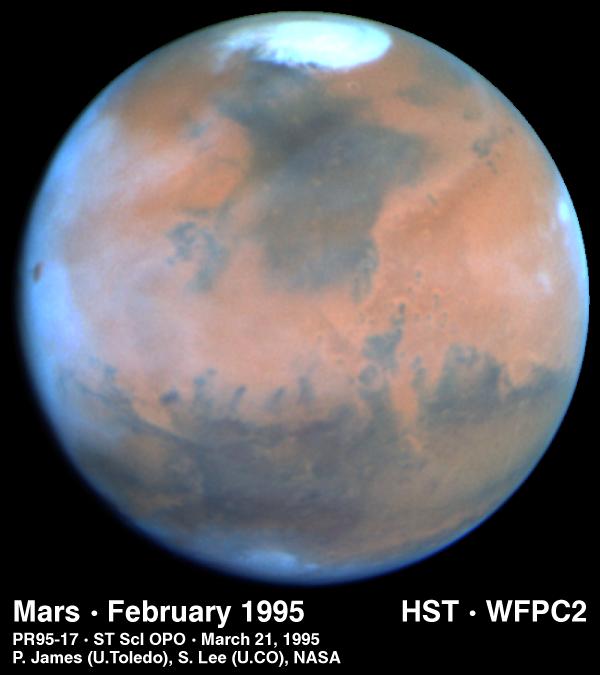NEEP602 Course Notes (Fall 1996)
Resources from Space
Lecture #14: The cool red hills of Mars!
Title: Evolution of Mars
 Comparison of Earth and Mars in space (NASA Photo).
Comparison of Earth and Mars in space (NASA Photo).
Radius 3390km vs 1738 km for Moon and ---km for Earth
Visuals:
Viking and Mariner views of Mars
Notes:
* Lunar Model probably applies reasonably well to Mars through the Cratered Highlands Stage (3.9? eons ago).
- * Evolution as a planet would be modified relative to Earth and Moon by
- * Intermediate gravitational field (3/8 of Earth's versus 1/6 on the Moon).
- * Greater distance from the sun (--less insolation per unit area).
- * Lack of interaction with a large Moon or possibly by the formation of a large moon by fission of the parent body.
- * Greater distance from the sun (--less insolation per unit area).
* Some implications of above factors on the planetary evolution of Mars.- * Greater size, relative to the Moon, caused lighter elements to be retained,
most significantly, water and carbon dioxide, but also elements of less
mass number than 22 (Na).
- * Without a strong intrinsic magnetic field, Mars' atmosphere is eroded by interactions with the solar wind (Kass and Yung, 1995).
- * Comparable offset of the center of mass and the center of figure (3km for Mars and 2km for the Moon) giving a strong hemispheric dichotomy to both (generally younger surfaces on the frontside of the Moon and in the northern hemisphere of Mars). (see Smith and Zuber, 1996)
- * Prolonged internal heat generation due to greater size resulted in extended structural disruption and vulcanism in the northern hemisphere, including major constructional volcanos.
- * No evidence for plate tectonic processes or extensive sedimentation, unlike the Earth, thus little or no recycling of the crust as on Earth and possibly Venus.
- * Early atmosphere may have been similar to Earth's, however, this atmosphere largely disappeared due to lower gravity, lack of a perpetual and strong magnetic field, and lower insolation contributed both to greater loses to space and "early" removal of water as ice.
- * Cratering effects would be modified by the presence of an atmosphere, including effects on ejecta transport and the filtering out of smaller events as a function of atmospheric density (similar to Earth and Venus).
- * Water ice observed at the poles, along with seasonal carbon dioxide frost.
- * Evidence for past surface water activity strong.
- * Without a strong intrinsic magnetic field, Mars' atmosphere is eroded by interactions with the solar wind (Kass and Yung, 1995).
* Major Stages of Martian Evolution (Synthesized largely from material presented by Munch, 1976; Carr, 1984, and the cratering age estimates of Soderblom, 1988)- * 1. Beginning 4.55 eons
- * 2. Magma Ocean 4.6-4.4? eons
- * 3. Cratered Highlands/Early Atmosphere 4.4?-3.9? eons
- * 4. Tharsis Uplift #1/Frozen Atmosphere 4.2?-3.9? eons
- * 5. Early "Mare" Cratered Plains/Flooding 3.9?-3.5? eons
- * 6. Tharsis Uplift #2/Valles Marineris/Channels 3.5?-2.5? eons
- * 7. Middle "Mare" Plains/Volcanos 3.5?-1.5? eons
- * 8. Late "Mare" Plains/Constructional Volcanos/Eolian Deposits 1.5?-0 eons
- * 2. Magma Ocean 4.6-4.4? eons
* 1. Beginning 4.55 eons- * Accretion from Solar Nebula (without possible complications of a large
moon)
- * Duration of a few hundred thousand years (?)
- * Duration of a few hundred thousand years (?)
* 2. Magma Ocean 4.5-4.4? eons- * Planet-wide differentiation of a silicon-rich crust and magnesium/iron
rich upper mantle (similar to Moon and Earth)
- * Iron-sulfur core formation with an early strong magnetic field (?) (similar to Earth?).
- * Final 3 km offset center of figure and center of mass probably led to a thicker crust in the southern hemisphere.
- * Iron-sulfur core formation with an early strong magnetic field (?) (similar to Earth?).
* 3. Cratered Highlands/Early Atmosphere 4.4?-3.9? eons- * Highly cratered crust including a few large basins but not nearly as many
as recorded on the Moon (general cratering was similar to Moon but possibly
even more intense and modified by the presence of an Earth-like atmosphere).
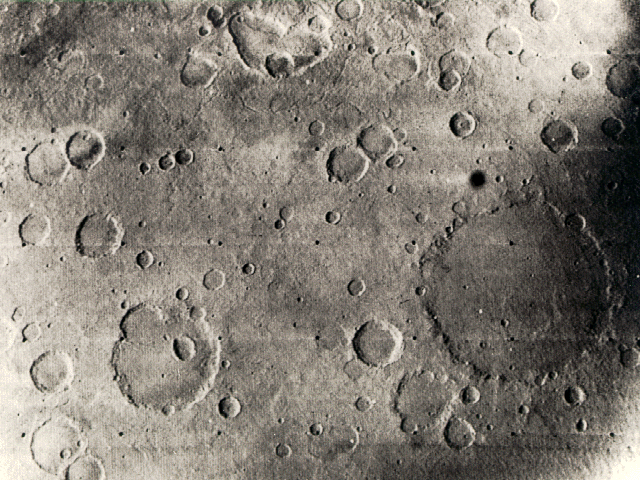 Cratered highlands (NASA Photo)
Cratered highlands (NASA Photo)
- * Large, sprawling, low relief volcanos/calderas.
 Alba Patera-volcano in grooved terrain (NASA Photo)
Alba Patera-volcano in grooved terrain (NASA Photo)
 Tyrrenum Patera-Radial volcano with channels (NASA Photo)
Tyrrenum Patera-Radial volcano with channels (NASA Photo)
- * Water cycle contributed to crater erosion, with the possible interlayering of sedimentary strata along with ejecta blankets.
- * Formation of intercrater plains, possibly by water deposition or lavas or both.
- * Water migrated into Martian crust.
* 4. Tharsis Uplift #1/Frozen Atmosphere 4.2?-3.9? eons- * Fracturing and uplift of a large region of the thin crust in the northern
hemisphere, probably due to phase transitions in the upper mantle as radiogenic
heat accumulated.
- * Formation of crustal ice and polar ice caps as atmospheric temperatures dropped due to reduced cratering rates and radiative cooling.
* 5. Early "Mare" Cratered Plains/Flooding 3.9-3.5? eons- * Residual liquid left from the Magma Ocean possibly entered the crust and
erupted to form cratered plains, and the possible formation of sedimentary
strata along with the lavas.
- * Subsequent cratering of the cratered plains continued as the cratering rate decreased, markedly.
- * Within 30-40o of the equator, plains features are crisp, lunar-like. At higher latitudes, plains features are much more complex.
- *Figure: Near equatorial cratered plains (NASA Photo). (to be supplied later)
- *Figure: High latitude cratered plains (NASA Photo). (to be supplied later)
- * Fretted (mesa, knob, and plains) terrain formed across the contact between cratered highlands and cratered plains.
- *Figure: Fretted terrain (NASA Photo). (to be supplied later)
- * Ridged plains apparently formed in response to stresses produced by the Tharsis dome.
- *Figure: Ridged plains (NASA Photo). (to be supplied later)
- * Structural break-up between northern and southern hemispheres possibly due to movement of residual liquid into and on to the crust.
- * Major flooding where Early Plains magmas melted crustal ice.
- * Most like (?) period for the development of precursors to simple life forms.
- * Subsequent cratering of the cratered plains continued as the cratering rate decreased, markedly.
* 6. Tharsis Uplift #2/Valles Marineris/Channels 3.5?-2.5? eons- * Continuing or new fracturing and uplift of a large region of the thin
crust in the northern hemisphere, probably due to melting and possibly convection
in the mantle.
- * Valles Marineris, a major extensional fracture, 5000 km long, probably formed in response to the same forces that produced the Tharsis Uplift #2.
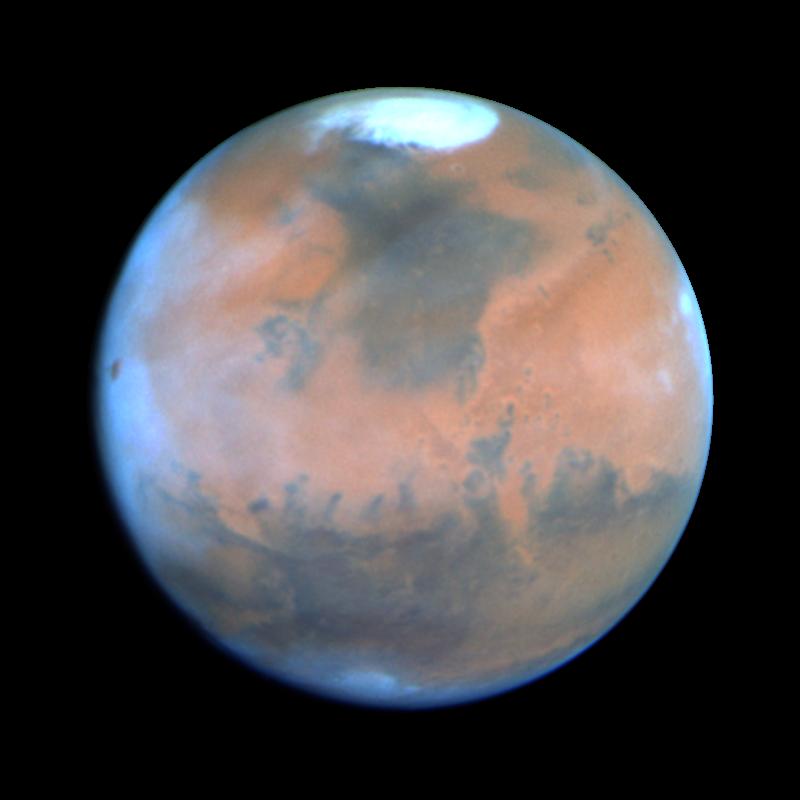 Valles Marineris (NASA Photo)
Valles Marineris (NASA Photo)
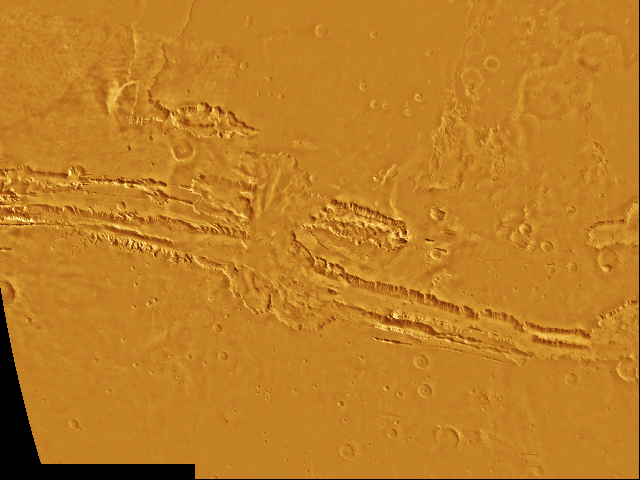 Full Image
Full Image
 Erosion channel (NASA Photo)
Erosion channel (NASA Photo)
- * Release of subsurface water along Valles Marineris.
- * Valles Marineris, a major extensional fracture, 5000 km long, probably formed in response to the same forces that produced the Tharsis Uplift #2.
* 7. Middle 'Mare" Plains/Constructional Volcanos/Erosion 3.5?-2.5? eons- * Continuation of volcanic plains formation, possibly with a transition
from residual liquid to "mare-like" lavas, and the possible formation of
sedimentary strata along with the lavas due to periodic or continuous melting
and surface runoff of crustal water.
- * Most likely (?) period for the evolution of simple life forms.
- * Occasional large impact events.
- * Significant water erosion and channel formation
- * Most likely (?) period for the evolution of simple life forms.
* 8. Late "Mare" Plains/Constructional Volcanos/ 2.5?-1.5? eons.- * Eruption of now unfractured lavas.
- * Occasional large impact events.
- *Figure: impact crater with evidence of fluidized ejecta (NASA Photo) (to be supplied later)
- * Occasional large impact events.
* 9. Constructional Volcanos/Eolian erosion 1.5?-0 eons- * Formation of four large constructional volcanos on the Tharsis Uplift.
 Olympus Mons- 500km by 24km high (NASA Photo)
Olympus Mons- 500km by 24km high (NASA Photo)
 Olympus Mons lava flows (NASA Photo)
Olympus Mons lava flows (NASA Photo)
 Tharsis Montes (NASA Photo)
Tharsis Montes (NASA Photo)
* Polar ice caps.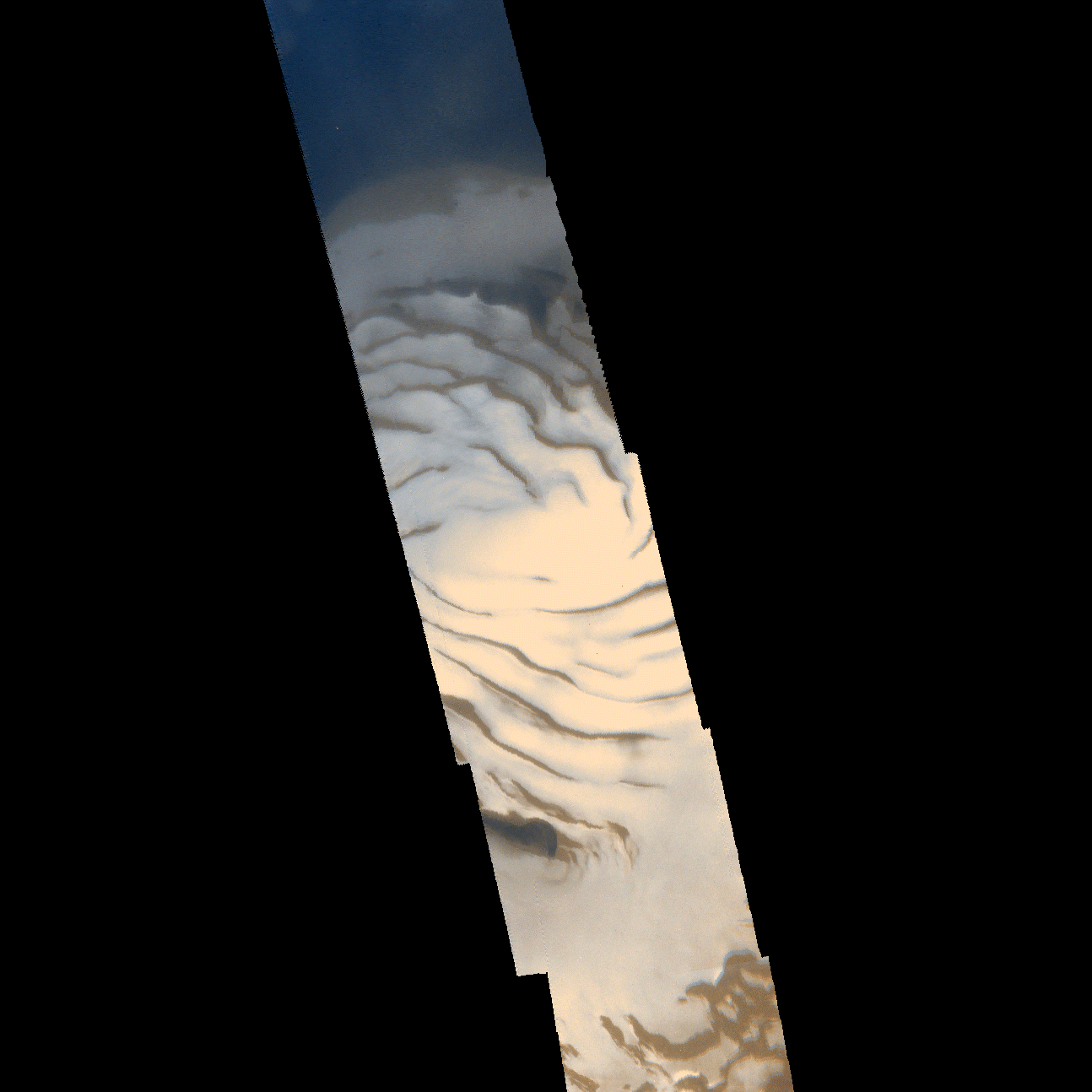 North polar ice cap (NASA Photo)
North polar ice cap (NASA Photo)
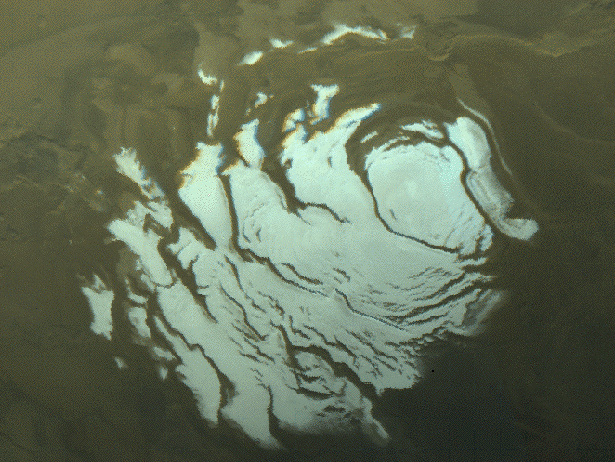 South polar ice cap (NASA Photo)
South polar ice cap (NASA Photo)
* Dust storms with associated erosion and deposition.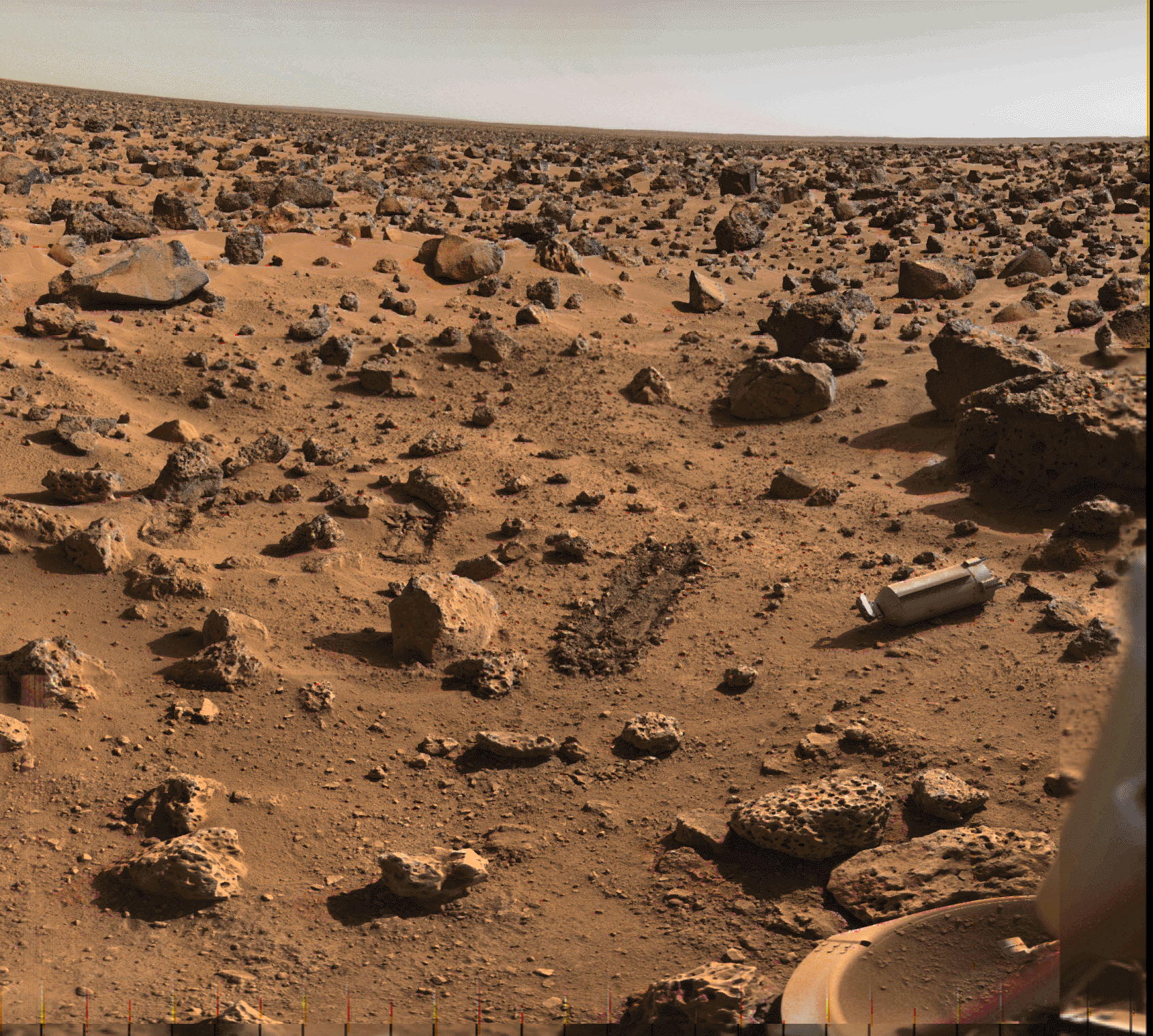 View from Viking lander (NASA Photo)
View from Viking lander (NASA Photo)
Life on Mars
* Arguments for early life-
- * Great age (>3.55 billion years) of earliest one cell life forms on Earth.
- * Evidence for an environment that allowed surface, and subsurface water to exist.
- * Implications of the model for lunar evolution on the nature of the surface environment of terrestrial planets when self replicating organic compounds (life) first formed, that is, intense cratering with production of fine-grained and glassy material, addition of extraplanetary material, and repeated peaks of high thermal energy.
- * Early planetary environment of Earth, Mars, and Venus (?) conducive to the formation of clays, i.e., wet with lots of fine grained glass particles.
- * Other planetary systems apparently capable of retaining liquid water, such as, 70 Virginis in the constellation Virgo (Science, v 271, 449-450)
- * Great age (>3.55 billion years) of earliest one cell life forms on Earth.
* Questions to be answered- * For how long and how frequently did surface water exist?
- * What overall environmental conditions existed at that time?
* Arguments against present life- * Viking analyses (Horowitz, 1988)
- * Present surface environment incompatible
* o Arguments for present life- * Viking analysis (Levin, 1988)
- * Potential ecological niches related to permafrost, subsurface weathering, and active hot springs, if present.
* Search for evidence of life- * Field geological search for fossil-bearing strata.
- * Drilling search for subsurface ecological niches.
- * Search the edges and strata in the ice caps.
- * Search for hot springs.
- * Drilling search for subsurface ecological niches.
Additional Notes:
* Based on the isotopic ratios of contained inert gases,12 meteorites from Mars have been collected from the Antarctic ice (Science News, 10/14/95). Some of these contain carbonates.
* Current weather on Mars via the Hubble telescope is cloudy, a consequence of an overall 20o !! cooling of the atmosphere since the late 1970s due to the lack of heat adsorbing dust in the atmosphere (Science, 3/31/95). Where is global warming when you need it!
* Bacteria are living more than 1000m deep into the Columbia River basalts, apparently with total independence from photosynthesis, getting their energy from the hydrogen generated by the breakdown of water during the chemical weathering of the iron minerals in the basalts (Science, 10/20/95). Great news for life beneath the surface of Mars!
Questions:
1. Discuss the rationale, if any, to assume that simple life forms developed on Mars and that they may have evolved to survive in some ecological niches to the present time.
2. Analyze and discuss the implications of the variations in solar energy received on the surface of Mars as a function of the planets orbital parameters and weather.
3. Where would you go to search for fossils and current life forms on Mars and why?
Text:
Mars environment material
References:
Carr, M.H., 1984, Mars, in M.H. Carr, et al, The Geology of the Terrestrial Planets, p207-263.
Gould, S.J., 1994, A Plea and a Hope for Martian Paleontology, in Neal, Valerie, editor, Where Next Columbus? The Future of Space Exploration, Oxford University Press, Oxford, 107-128p.
Horowitz, N.H., 1998, The Biological Question of Mars, in D.B. Reiber, editor, The NASA Mars Conference, AAS Science and Technology Series, v 71, 177185.
Kass, D.M., and Yung, Y.L., 1995, Loss of Atmosphere from Mars Due to Solar Wind-Induced Sputtering, Science, v 268, 697-699.
Levin, G.V., 1988, A Reappraisal of Life on Mars, in D.B. Reiber, editor, The NASA Mars Conference, AAS Science and Technology Series, v 71, 187-208.
Munch, T.A., et al, 1976, The Geology of Mars, Princeton University Press, Princeton, 400p.
Smith, D.E., and Zuber, M. T, 1996, The shape of Mars and the Topographic Signature of the Nemispheric Diochotomy, Science, v 271, 184-188.
Soderblom, L.A. 1988, The Geology of Mars, in D.B. Reiber, editor, The NASA Mars Conference, AAS Science and Technology Series, v 71, 43-53.
 |
|
University of Wisconsin Fusion Technology Institute · 439 Engineering Research Building · 1500 Engineering Drive · Madison WI 53706-1609 · Telephone: (608) 263-2352 · Fax: (608) 263-4499 · Email: fti@engr.wisc.edu |
Copyright © 2003 The Board of
Regents of the University of Wisconsin System.
For feedback or accessibility issues, contact
web@fti.neep.wisc.edu.
|
